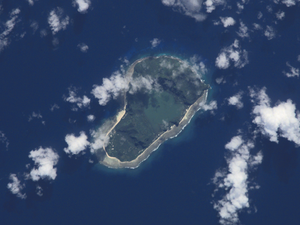Tikopia
| Tikopia (Tukopia) | ||
|---|---|---|
| Satellite image | ||
| Waters | Pacific Ocean | |
| Archipelago | Santa Cruz Islands | |
| Geographical location | 12 ° 17 '47 " S , 168 ° 49' 55" E | |
|
|
||
| length | 3.8 km | |
| width | 2.1 km | |
| surface | 5 km² | |
| Highest elevation | Mount Reani 380 m |
|
| Residents | 1062 (2009) 212 inhabitants / km² |
|
| main place | Matautu | |
| Historical map of Tikopias (1943–1945) | ||
Tikopia is the southernmost inhabited island in the Solomon Islands . Further south, only the uninhabited Little Nottingham Islet is in the Indispensable Reefs . On ancient maps, Tikopia is also called Tukopia . The first European to sight the island was Pedro Fernández de Quirós in 1606.
Geography and climate
Tikopia is part of the Santa Cruz Islands and belongs to the Temotu Province of the Solomon Islands. The closest island is Anuta , 132 km northeast , which, like Tikopia, is a Polynesian exclave .
The island is the remnant of an extinct volcano . Its highest point, Mount Reani, reaches a height of 380 m above sea level. The land area is approximately 5 km². In the center of the island is the approximately 80 m deep Lake Te Roto , a crater lake.
A drought in 1952 and 1953 claimed 17 lives on the island of Tikopia.
population
Tikopia is inhabited by 1062 people who live in over 25 villages mostly along the coast. The largest village is Matautu on the west coast, not to be confused with Mata-Utu , the capital of Wallis and Futuna . In contrast to most of the islands of the Solomon Group, whose inhabitants are of Melanesian descent, the inhabitants of Tikopia have Polynesian roots. The island is therefore one of the Polynesian exclaves in the Solomon group. They speak the Tikopian language , which is part of the Samoan branch of the Polynesian languages .
In the past, the population was consistently around 1000, as the small island could not support a large number of people with the traditional Polynesian farming methods. In order not to exceed this population, strict birth control was practiced. Only the eldest son in each family was allowed to father children. If an unwanted child was born, it was inevitably doomed.
Management
The island's limited resources have been developed and used using tried and tested Polynesian agricultural methods. These were based on the population density. From centuries of experience, the Polynesians knew how to manage the limited livelihoods of small islands: For example, once (around the year 1600) the number of pigs being bred became too large, the islanders decided to slaughter them and turn to fishing again to obtain animal protein. because the pigs consumed too much agricultural products and thus prevented a balanced diet for the people.
Culture
The Tikopian culture was highly developed and had a complex social structure, as found in many Polynesian societies. Religious concepts and taboos were followed consistently. Due to the framework conditions set by them (care of resources, birth control), the population was able to manage their small island successfully and - as early visitors described it - create a "little paradise".
today
The people of Tikopia still maintain their cultural traditions today. However, the influence of Christianity has changed many of the ancient customs. With a large number of young men leaving the island to find work on other islands, the problem of birth control is no longer as pressing as it used to be. In December 2002 the island fell victim to cyclone " Zoe ". Although large parts of the settlements and vegetation were destroyed, there were no fatalities. Relief campaigns got off to a slow start worldwide. However, some more or less private donations and material deliveries reached the island weeks and months later. The chiefs decided to make a selection among the relief supplies so that the cultural identity would be preserved. For example, alcohol and outboard motors are prohibited.
literature
- Jared Diamond : Collapse. Why societies survive or perish. S. Fischer, Frankfurt am Main 2005, ISBN 3-10-013904-6 , pp. 357ff.
- Heide Wilts: Islands Beyond Time. With the FREYDIS through Melanesia. Delius Klasing, Bielefeld 2008, ISBN 978-3-7688-2499-6 , p. 105 ff.
- Patrick Vinton Kirch and DE Yen: Tikopia, the Prehistory and Ecology of a Polynesian Outlier (Bernice P. Bishop Museum Bulletin, 238), Honolulu, July 1982, ISBN 978-0910240307 .
Web links
- Essay on Tikopia for the BBC (English)
- BBC photo series about the effects of cyclone "Zoe" (Text: English)
- Tools for rebuilding (English)
Individual evidence
- ^ Judith Schalansky : Atlas of the remote islands . Fifty islands that I've never been and never will be. 7th edition. Mare-Verlag, Hamburg 2010, ISBN 978-3-86648-117-6 , p. 116.
- ↑ Page 38 ( page no longer available , search in web archives ) Info: The link was automatically marked as defective. Please check the link according to the instructions and then remove this notice.


